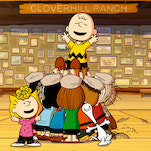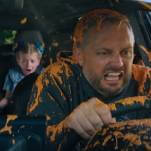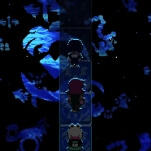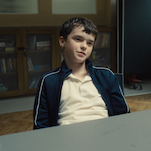Doctor Who (Classic): “The Green Death”
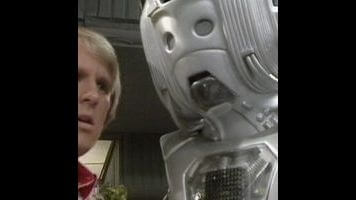
“The Green Death” (season 10, episodes 21-26. Originally broadcast May 19-June 23, 1973.)
“The Green Death” is a bit of a mixed bag. On the one hand, it’s got several of the most memorable moments of the Third Doctor era, ranging from the singularly horrific—the giant carnivorous maggots that spawn from the industrial pollution of the title—to the genuinely moving, as the Doctor bids a fond farewell to his daughter-figure assistant Jo Grant. On the other hand, it’s also frustratingly uneven, sloppily constructed, and full of well-intentioned environmentalist and anti-corporate themes that are often abandoned or underdeveloped. On the third hand, you get to see Jon Pertwee in drag disguised as a cleaning lady, which I suppose could be either a positive or a negative depending on your point of view.
One of the hallmarks of the Pertwee era were stories that went beyond the monster-of-the-week template and tried to tackle social and political issues—part of the reason so many Third Doctor serials took place on Earth was to keep confronting him with problems that ordinary humans had to face. This was particularly important to the show’s then-producer, Barry Letts, so it’s no wonder that it’s especially prominent in the anti-pollution angle of “The Green Death,” considering that Letts co-wrote the script along with Robert Sloman. I get the impression, though, that the writers found the topic a bit too complicated to wrestle into the Doctor Who format. Based on the first couple of episodes of this six-parter, “The Green Death” looks like it’s setting up a more complex exploration of the environmental issues it raises than what it delivers later, when the story settles into a fight-the-monsters action mode and its primary villain turns out to be more interested in conquering the world than poisoning it, back-burnering the plot elements that actually launched the story.
The first episode begins promisingly, setting up several conflicting factions in Llanfairfach, a mining town in Wales, who are all confronted with the sudden appearance of highly toxic, glowing green slime seeping out of the earth. First, there’s the executives at Global Chemicals, who are secretly responsible for the Green Death and the giant maggots it spawns because they’ve chosen to bury the toxic byproduct of their new oil-processing system, potentially worth billions. Though they’re led by the appropriately slimy Stevens, who offers hollow-sounding promises of wealth for everyone, they’re not monolithically evil, and at least one of them hopes to stop his company’s devastation. Stevens, we’ll discover, also has a guilty conscience, though he’ll have a harder time trying to do the right thing.
Opposing the corporation is a free-spirited group of counterculture activists and scientists led by the charismatic Cliff Jones, who live on a hippie-commune farm called Wholeweal, or informally “the Nut Hutch.” Their big project is magic mushrooms—or, at least, a super-fungus they’re cultivating which has the potential to end world hunger. That becomes important later on, but first they show up at the GloboChem headquarters to harangue Stevens about his company raking in profits while spilling poisons everywhere.
Caught between those two are the Welsh miners themselves. Working-class and local, their concerns are largely economic: The mines are shut down, and they’ve all been thrown out of work. So they’re willing to listen to Stevens’ lies about how GloboChem will bring money back to the area, and they’re impatient with Jones’ argument that they’re being exploited, selling their health and their land for a too-small part of the profit. They think he’s a rich dilettante who’s a little hypocritical about insisting that the environment is more important than their jobs, pointing out that “It's all right for you. You can afford to live the way you want to.” It’s a genuine concern, and one that the story really should have tried to address if its environmental message was intended to be more than superficial. But the story abandons the Welsh miners after the third episode, resolving their concerns about the economic devastation caused by closing the mines by simply never bringing it up again.
But before that happens. the mysterious slime-caused deaths force the company to call in UNIT to investigate—and it turns out that divisions are running deeper than usual over there, too. The no-nonsense Brigadier is concerned about the possibility of industrial sabotage, putting him at least nominally on the side of the corporation. Jo, meanwhile, has been reading about the work being done at Jones’ commune, and embraces their cause with the slightly confused enthusiasm of a new convert: “It's time that the world awoke to the alarm bell of pollution instead of sliding down the slippery slopes of, of, of, whatever it is.” She flatly refuses to help the Brigadier work with Global Chemicals. More fair-minded than the Doctor ever gives him credit for, the Brig offers Jo a ride to visit Jones, since they’re both going to Llanfairfach anyway.
And the Doctor finds himself on the outs with both of them. Enthused about a long-planned visit to the planet Metebelis Three, he rejects the Brig’s Llanfairfach assignment with the sneer that “I’m not a policeman,” and never mind that glowing green corpses are exactly the sort of thing he should be investigating. But he’s also shocked to realize Jo doesn’t want to travel the universe with him either, having found more important things to fight for on Earth. He’s especially startled to hear Jo’s hero-worshippy attitude toward Jones, who she hasn’t met yet but thinks of as “a younger you,” already a little in love with him. (Just as Jones is consciously depicted as a younger version of the Doctor himself, Jo’s first meeting with him is a riff on her first meeting with the Doctor, accidentally interrupting one of his experiments and getting confused about his identity.) Jo’s relationship with the Doctor, more than most Doctor Who companion pairings, is very much a father/daughter dynamic, and he can see that she might be growing away from him the way a real daughter would. She is, to coin a phrase, growing up.
The problem with Jo is that this kind of characterization often comes across as patronizing and even sexist, and yet I think in her case the best way to make her character work is to depict her as a bit of a child—the Doctor’s unworldly but brave teenage daughter, say—despite that Katy Manning was in her mid-to-late 20s when she played the character. When Jo is written properly, she’s among my favorite Doctor Who companions, not only sweet and endearing in her own right but helping to humanize the Third Doctor, who was often off-puttingly arrogant and humorless without her. Jo may have been originally introduced (in “Terror Of The Autons”) as an independent Emma Peel-esque action-lady type, but Manning’s petite physical presence made a more childlike demeanor work better for the character. That shouldn’t mean that she’s depicted as stupid: She carries a great deal of the story in “The Curse Of Peladon,” for instance, by approaching things as a wise-beyond-her-years but often still naive teenager.




